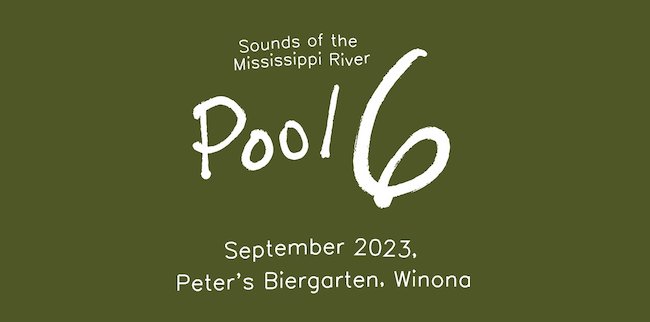Sounds of the Mississippi River Pool 6

September 10-17 | 9 am-6 pm
Peter’s Biergarten | 54 E 3rd St.
los.st/pool6/
From September 10th through the 17th, the sounds of the Mississippi River will be projected into Winona’s downtown Biergarten. (Until then, the stream is playing recordings made of the river during the summer of 2023.)
Two hydrophones submerged in the water near Levee Park, will stream the sounds of the river into the Biergarten space during the day.
A hydrophone is a microphone designed for underwater use. These hydrophones are encased in a special resin that is close to the density of the water which helps us hear the sounds as clearly as we can.
The river is home to many creatures like beaver, muskrats, birds, waterfowl and many species of fish — over 140 species of fish! Including Herring, Sturgeon, Bluegill, Walleye and Freshwater Drum. [1]
We hear the familiar sounds above water: birds calling, wind rustling through the trees, waves splashing along the river edge, boats passing, squirrels chattering.
The underwater residents in the area are actually pretty noisy too, but their sound world is pretty different from ours. They make sounds as they move around, swim, eat and go about their underwater activities.
Many fish also make sounds on purpose.
For example, the Freshwater Drum get their name from the loud drumming sound they make with special muscles connected to their swim bladders. It sounds a bit like a woodpecker, you may be able to hear them drumming now. [2]
Human sounds make their way into the water too. Boat motors sound a bit more like a spaceship underwater. Sometimes it’s possible to hear the faint high frequency clicking of a fish finding device, too. You can tell it apart from the clicking sounds that fish make because the rhythm is perfectly regular and robotic. Fish click much more freely.
Many fish produce sounds via stridulation — in other words by means of friction. For example, by grinding their teeth or flicking their fin spines. These sounds are sometimes also amplified by their swim bladders. The air-filled bladder acts like a resonator to intensify the sound. Some fish also use special muscles to push on their swim bladders and make even louder sounds, like the Freshwater Drum.
This project was produced by Erik Schoster and Jason Nanna for LOSST (Letters On Sounds, Signals, Time).
Thanks to Carlos Espinosa of Peter’s Biergarten and Captain Aaron of the Winona Tour Boat for the generous use of their facilities.
[1] R. Norwick, J. Janvrin, S. Zigler, R. Kratt Habits and Habitats of Fishes in the Upper Mississippi River
[2] Rodney Roundtree Listening to Fish
Erik Schoster is a member of the River Arts Alliance. To learn more about the benefits of membership, please visit: https://riverartsalliance.org/membership/.
